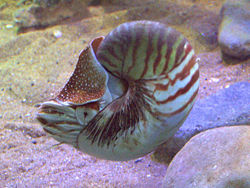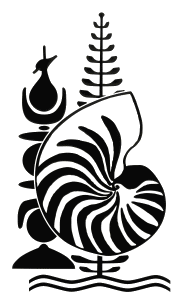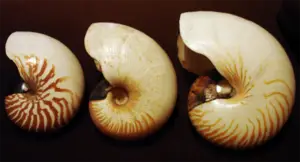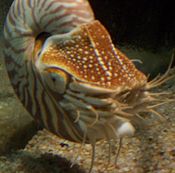Difference between revisions of "Nautilus" - New World Encyclopedia
Rick Swarts (talk | contribs) |
Rick Swarts (talk | contribs) |
||
| Line 23: | Line 23: | ||
'''Nautilus''' (from Greek ''nautilos'', "sailor') is the common name of any marine creatures of the [[cephalopod]] family '''Nautilidae''', the sole family of the suborder '''Nautilina'''. | '''Nautilus''' (from Greek ''nautilos'', "sailor') is the common name of any marine creatures of the [[cephalopod]] family '''Nautilidae''', the sole family of the suborder '''Nautilina'''. | ||
| − | Cephalopods generally are divided into three subclasses: [[Ammonoidea]] (ammonoids), Coleoidea (octopus, squid, | + | Cephalopods generally are divided into three subclasses: [[Ammonoidea]] (extinct ammonoids), Coleoidea ([[octopus]]es, [[squid]]s, cuttlefishes, extinct belemites), and Nautiloidea. The nautilus is the only extant (living) representatives of the subclass Nautiloidea, a subclass that fourished 300 million years ago during the [[Paleozoic]]. |
| − | + | Nautilus differs from other exant cephalopods by having an external shell and one pair of gills rather than two (Vecchione 2006). While female argonauts do secrete a shell-like egg case, this paper-thin structure lacks the gas-filled chambers present in chambered nautilus shells and is not a true cephalopod shell, but rather an innovation unique to the genus ''Argonauta'' (Naef 1923). | |
| − | + | Nautiluses typically have more tentacles than other cephalopods, up to 90, whereas octopuses have 8 tentacles, and squids and the squid-like cuttlefishes have 10. | |
| + | Nautilidae comprises 6 very similar species in 2 genera, the type genus of which is ''Nautilus''. The term "chambered nautilus," though it more specifically refers to the species ''Nautilus pompilius'', is also used for any species of the Nautilidae. | ||
| − | + | Nautiluses have survived relatively unchanged for millions of years and often are considered to be "living fossils." | |
| − | |||
| − | |||
| − | + | ==Description== | |
| − | + | The nautilus is similar in general form to other cephalopods, with a prominent head and a foot modified into numerous tentacles. The tentacles of nautiluses differ from other cephalopods not only in being greater in number, but also in lacking suckers. These tentacles are arranged into two circles and are undifferentiated and retractable. | |
| − | The | ||
| − | |||
| + | The radula (toothed ribbon used for grazing and scraping) is wide and distinctively has nine teeth. | ||
| − | + | Like other cephalopods, nautilus has a closed circulatory system. There are two pairs of gills, whereas other extand cephalopods has one pair. | |
| − | |||
| − | |||
| − | + | The majority of nautiluses never exceed 20 cm, in diameter but ''Nautilus pompilius'', is the largest species in the genus, has a form from western [[Australia]] that may reach 26.8 cm. ''Nautilus macromphalus'' is the smallest species, usually measuring only 16 cm. | |
| − | + | ===The shell=== | |
| + | [[Image:Nautilus species shells.png|thumb|left|300px|Nautilus shells: ''N. macromphalus'' (left), ''A. scrobiculatus'' (center), ''N. pompilius'' (right)]] | ||
| + | Nautiluses are the sole cephalopods whose bony structure of the body is externalized as a shell. The animal can withdraw completely into its shell, closing the opening with a leathery hood formed from two specially folded tentacles. The shell is coiled, calcareous, mother-of-pearl-lined and pressure resistant (imploding at a depth of about 800 m). | ||
| − | + | The nautilus shell is composed of 2 layers: the outer layer is a matte white, while the inner layer is a striking white with iridescence. The innermost portion of the shell is pearlescent, blue-gray. The '''osmena pearl''', contrarily to its name, is not a [[pearl]], but a jewelry product derived from this part of the shell. | |
| + | The shell is internally divided into chambers, the chambered section being called the phragmocone. The phragmocone is divided into camerae by septa, all of which are pierced in the middle by a duct, the siphuncle. As the nautilus matures its body moves forward, sealing the camerae behind it with a new septum. The last fully open chamber, also the largest one, is used as the living chamber. The number of camerae increases from around four at the moment of hatching to thirty or more in adults. | ||
| − | + | The shell coloration also keeps the animal cryptic (able to avoid observation) in the water. When seen from the top, the shell is darker in color and marked with irregular stripes, which makes it blend into the darkness of the water below. On the contrary, the underside is almost completely white, making the animal indistinguishable from brighter waters near the ocean surface. This mode of [[camouflage]] is named countershading. | |
| − | The | ||
| − | + | The nautilus shell presents one of the finest natural examples of a logarithmic spiral. (It is sometimes incorrectly claimed to be a golden spiral—that is, related to the golden ration—as well.) | |
| − | |||
| − | |||
| − | |||
| − | |||
| − | |||
| − | |||
| − | |||
| − | |||
| − | |||
| − | The nautilus shell presents one of the finest natural examples of a | ||
<gallery> | <gallery> | ||
Image:NautilusTop.jpg|A nautilus shell when viewed from above | Image:NautilusTop.jpg|A nautilus shell when viewed from above | ||
Image:NautilusBottom.jpg|The same shell viewed from underneath | Image:NautilusBottom.jpg|The same shell viewed from underneath | ||
| − | Image:NautilusCutawayLogarithmicSpiral.jpg|Hemishell showing the camerae in a | + | Image:NautilusCutawayLogarithmicSpiral.jpg|Hemishell showing the camerae in a logarithmic spiral |
</gallery> | </gallery> | ||
===Buoyancy and movement=== | ===Buoyancy and movement=== | ||
| − | In order to swim, the nautilus draws water into and out of the living chamber with the [[hyponome]], which makes use of | + | In order to swim, the nautilus draws water into and out of the living chamber with the [[cephalopod#Locomotion|hyponome]], which makes use of jet propulsion. |
| − | + | When water is inside the chamber, the siphuncle extracts [[salt]] from it and diffuses it into the [[blood]]. When water is pumped out, the animal adjusts its buoyancy with the gas contained in the chamber. Buoyancy can be controlled by the [[osmosis|osmotical]] pumping of gas and fluid into or from the camerae along the siphuncles. The control of buoyancy in this manner limits the nautilus; they cannot operate under extreme hydrostatic pressures. | |
| − | In the wild, nautiluses usually inhabit depths of about 300 m, rising to around 100 m at night for feeding, mating and [[Egg (biology)|egg]] laying. The shell of the nautilus cannot withstand depths greater than approximately 800 m. | + | The animal can also crawl on land or on the seabed. |
| + | |||
| + | In the wild, nautiluses usually inhabit depths of about 300 m, rising to around 100 m at night for feeding, mating, and [[Egg (biology)|egg]] laying. The shell of the nautilus cannot withstand depths greater than approximately 800 m. | ||
[[Image:Nautilus tentacles.jpg|thumb|right|175px|Nautilus tentacles]] | [[Image:Nautilus tentacles.jpg|thumb|right|175px|Nautilus tentacles]] | ||
===Diet and sensory system=== | ===Diet and sensory system=== | ||
| − | Nautiluses are | + | Nautiluses are predators and feed mainly on [[shrimp]], small [[fish]], and [[crustacean]]s, which are captured by the tentacles. However, due to the very little energy they devote to swimming, they need only eat once a month. |
| + | |||
| + | Unlike other cephalopods, they do not have good vision; their [[eye]] structure is highly developed but lacks a solid lens. They have a simple "pinhole" lens through which water can pass. Instead of vision, the animal is thought to use [[olfaction]] as the primary sensory means during foraging, locating, or identifying potential mates. | ||
===Reproduction and lifespan=== | ===Reproduction and lifespan=== | ||
| − | Nautiluses are | + | Nautiluses are male or female, and are sexually dimorphic, with structural or size differences between the males and females. They reproduce by laying [[egg (biology)|egg]]s. Attached to rocks in shallow waters, the eggs take twelve months to develop before hatching out at around 30 mm long. Females spawn once per year and regenerate their gonads, making nautiluses the only cephalopods to present polycyclic spawning or iteroparity (producing a few large eggs in each batch and living for a long time). Other cephalopods tend towards a semelparous reproduction strategy: they lay many small eggs in one batch and die afterwards. |
| + | |||
| + | The lifespan of nautiluses is about 20 years, which is exceptionally long for a cephalopod. With a few exceptions, Coleoidea (octopus, squid, cuttlefish) live short lives with rapid growth and high metabolism and life expectancy may be a few months to one or two years. | ||
==Natural history== | ==Natural history== | ||
| Line 207: | Line 201: | ||
*Sweeney, M.J. 2002. [http://tolweb.org/accessory/Nautilidae_Taxa?acc_id=2324 Taxa Associated with the Family Nautilidae Blainville, 1825.] Tree of Life web project. | *Sweeney, M.J. 2002. [http://tolweb.org/accessory/Nautilidae_Taxa?acc_id=2324 Taxa Associated with the Family Nautilidae Blainville, 1825.] Tree of Life web project. | ||
*Ward, P.D. 1988. ''In Search of Nautilus''. Simon and Schuster. | *Ward, P.D. 1988. ''In Search of Nautilus''. Simon and Schuster. | ||
| + | |||
| + | .<ref>{{de icon}} {{cite journal | author = Naef, A. | year = 1923 | title = Die Cephalopoden, Systematik | journal = Fauna Flora Golf. Napoli (35) | volume = 1 | pages = 1-863}}</ref> | ||
| + | |||
==External links== | ==External links== | ||
Revision as of 02:58, 20 January 2007
| Nautilus | ||||||||||||||
|---|---|---|---|---|---|---|---|---|---|---|---|---|---|---|
 Nautilus pompilius
| ||||||||||||||
| Scientific classification | ||||||||||||||
| ||||||||||||||
|
Allonautilus |
Nautilus (from Greek nautilos, "sailor') is the common name of any marine creatures of the cephalopod family Nautilidae, the sole family of the suborder Nautilina. Cephalopods generally are divided into three subclasses: Ammonoidea (extinct ammonoids), Coleoidea (octopuses, squids, cuttlefishes, extinct belemites), and Nautiloidea. The nautilus is the only extant (living) representatives of the subclass Nautiloidea, a subclass that fourished 300 million years ago during the Paleozoic.
Nautilus differs from other exant cephalopods by having an external shell and one pair of gills rather than two (Vecchione 2006). While female argonauts do secrete a shell-like egg case, this paper-thin structure lacks the gas-filled chambers present in chambered nautilus shells and is not a true cephalopod shell, but rather an innovation unique to the genus Argonauta (Naef 1923).
Nautiluses typically have more tentacles than other cephalopods, up to 90, whereas octopuses have 8 tentacles, and squids and the squid-like cuttlefishes have 10.
Nautilidae comprises 6 very similar species in 2 genera, the type genus of which is Nautilus. The term "chambered nautilus," though it more specifically refers to the species Nautilus pompilius, is also used for any species of the Nautilidae.
Nautiluses have survived relatively unchanged for millions of years and often are considered to be "living fossils."
Description
The nautilus is similar in general form to other cephalopods, with a prominent head and a foot modified into numerous tentacles. The tentacles of nautiluses differ from other cephalopods not only in being greater in number, but also in lacking suckers. These tentacles are arranged into two circles and are undifferentiated and retractable.
The radula (toothed ribbon used for grazing and scraping) is wide and distinctively has nine teeth.
Like other cephalopods, nautilus has a closed circulatory system. There are two pairs of gills, whereas other extand cephalopods has one pair.
The majority of nautiluses never exceed 20 cm, in diameter but Nautilus pompilius, is the largest species in the genus, has a form from western Australia that may reach 26.8 cm. Nautilus macromphalus is the smallest species, usually measuring only 16 cm.
The shell
Nautiluses are the sole cephalopods whose bony structure of the body is externalized as a shell. The animal can withdraw completely into its shell, closing the opening with a leathery hood formed from two specially folded tentacles. The shell is coiled, calcareous, mother-of-pearl-lined and pressure resistant (imploding at a depth of about 800 m).
The nautilus shell is composed of 2 layers: the outer layer is a matte white, while the inner layer is a striking white with iridescence. The innermost portion of the shell is pearlescent, blue-gray. The osmena pearl, contrarily to its name, is not a pearl, but a jewelry product derived from this part of the shell.
The shell is internally divided into chambers, the chambered section being called the phragmocone. The phragmocone is divided into camerae by septa, all of which are pierced in the middle by a duct, the siphuncle. As the nautilus matures its body moves forward, sealing the camerae behind it with a new septum. The last fully open chamber, also the largest one, is used as the living chamber. The number of camerae increases from around four at the moment of hatching to thirty or more in adults.
The shell coloration also keeps the animal cryptic (able to avoid observation) in the water. When seen from the top, the shell is darker in color and marked with irregular stripes, which makes it blend into the darkness of the water below. On the contrary, the underside is almost completely white, making the animal indistinguishable from brighter waters near the ocean surface. This mode of camouflage is named countershading.
The nautilus shell presents one of the finest natural examples of a logarithmic spiral. (It is sometimes incorrectly claimed to be a golden spiral—that is, related to the golden ration—as well.)
Buoyancy and movement
In order to swim, the nautilus draws water into and out of the living chamber with the hyponome, which makes use of jet propulsion.
When water is inside the chamber, the siphuncle extracts salt from it and diffuses it into the blood. When water is pumped out, the animal adjusts its buoyancy with the gas contained in the chamber. Buoyancy can be controlled by the osmotical pumping of gas and fluid into or from the camerae along the siphuncles. The control of buoyancy in this manner limits the nautilus; they cannot operate under extreme hydrostatic pressures.
The animal can also crawl on land or on the seabed.
In the wild, nautiluses usually inhabit depths of about 300 m, rising to around 100 m at night for feeding, mating, and egg laying. The shell of the nautilus cannot withstand depths greater than approximately 800 m.
Diet and sensory system
Nautiluses are predators and feed mainly on shrimp, small fish, and crustaceans, which are captured by the tentacles. However, due to the very little energy they devote to swimming, they need only eat once a month.
Unlike other cephalopods, they do not have good vision; their eye structure is highly developed but lacks a solid lens. They have a simple "pinhole" lens through which water can pass. Instead of vision, the animal is thought to use olfaction as the primary sensory means during foraging, locating, or identifying potential mates.
Reproduction and lifespan
Nautiluses are male or female, and are sexually dimorphic, with structural or size differences between the males and females. They reproduce by laying eggs. Attached to rocks in shallow waters, the eggs take twelve months to develop before hatching out at around 30 mm long. Females spawn once per year and regenerate their gonads, making nautiluses the only cephalopods to present polycyclic spawning or iteroparity (producing a few large eggs in each batch and living for a long time). Other cephalopods tend towards a semelparous reproduction strategy: they lay many small eggs in one batch and die afterwards.
The lifespan of nautiluses is about 20 years, which is exceptionally long for a cephalopod. With a few exceptions, Coleoidea (octopus, squid, cuttlefish) live short lives with rapid growth and high metabolism and life expectancy may be a few months to one or two years.
Natural history
Cephalopods appeared 500 million years ago during the late Cambrian and were dominant and diverse during the Paleozoic and Mesozoic eras. Tommotia, a basal cephalopod, had squid-like tentacles but also a snail-like foot it used to move across the seabed. Early cephalopods were at the top of the food chain.
The ancient (cohort Belemnoidea) and modern (cohort Neocoleoidea) coleoids, as well as the ammonoids, all seemed to have diverged from the external shelled nautiloid during the middle Paleozoic Era, between 450 and 300 million years ago. While Nautiloid was dominant in the Paleozoic, ammonites were dominant during the Mesozoic.
Fossil records indicate that nautiluses have not evolved much during the last 500 million years, and nautiloids were much more extensive and varied 200 million years ago. Many were initially straight-shelled, as in the extinct genus Lituites. They developed in the Cambrian period and became a significant sea predator in the Ordovician period. Certain species reached over 2.5 meters in size. The other cephalopod subclass, Coleoidea, diverged from the Nautilidae long ago and the nautilus has remained relatively unchanged since. Extinct relatives of the nautilus include ammonites, such as the baculites and goniatites.
| Paleozoic era (542 - 251 mya) | |||||
|---|---|---|---|---|---|
| Cambrian | Ordovician | Silurian | Devonian | Carboniferous | Permian |
Classification
Overview of placement within Cephalopoda
CLASS CEPHALOPODA
- Subclass Nautiloidea: all cephalopods except ammonoids and coleoids
- (Order Plectronocerida): the ancestral cephalopods from the Cambrian Period
- (Order Ellesmerocerida): include the ancestors of all later cephalopods
- (Order Endocerida)
- (Order Actinocerida)
- (Order Discosorida)
- (Order Pseudorthocerida)
- (Order Tarphycerida)
- (Order Oncocerida)
- (Order Orthocerida)
- (Order Ascocerida)
- (Order Bactritida): include the ancestors of ammonoids and coleoids
- Order Nautilida: nautilus and its fossil relatives
- Suborder Nautlina
- Family Nautilidae
- Suborder Nautlina
- Subclass Ammonoidea): extinct ammonites and kin
- Subclass Coleoidea (octopus, squid, cuttlefish, extinct belemites)
Genus Nautilus
The genus Nautilus contains six extant species and several extinct species.
- Genus Allonautilus
- Allonautilus perforatus
- Allonautilus scrobiculatus
- Genus Nautilus
- Nautilus belauensis
- †Nautilus clarkanus
- †Nautilus cookanum
- Nautilus macromphalus
- Nautilus pompilius (type)
- Nautilus pompilius pompilius
- Nautilus pompilius suluensis
- †Nautilus praepompilius
- Nautilus stenomphalus
Dubious or uncertain taxa
| Binomial name and author citation | Current systematic status | Type locality | Type repository |
|---|---|---|---|
| Nautilus alumnus Iredale, 1944 | Species dubium [fide Saunders (1987:49)] | Queensland, Australia | Not designated [fide Saunders (1987:49)] |
| Nautilus ambiguus Sowerby, 1848 | Species dubium [fide Saunders (1987:48)] | Not designated | Unresolved |
| Nautilus beccarii Linne, 1758 | Non-cephalopod; Foraminifera [fide Frizzell and Keen (1949:106)] | ||
| Nautilus calcar Linne, 1758 | ?Non-cephalopod; Foraminifera Lenticulina | Adriatic Sea | Unresolved; Linnean Society of London? |
| Nautilus crispus Linne, 1758 | Undetermined | Mediterranean Sea | Unresolved; Linnean Society of London? |
| Nautilus crista Linne, 1758 | Non-cephalopod; Turbo [fide Dodge (1953:14)] | ||
| Nautilus fascia Linne, 1758 | Undetermined | Adriatic Sea | Unresolved; Linnean Society of London? |
| Nautilus granum Linne, 1758 | Undetermined | Mediterranean Sea | Unresolved; Linnean Society of London? |
| Nautilus lacustris Lightfoot, 1786 | Non-cephalopod; Helix [fide Dillwyn (1817:339)] | ||
| Nautilus legumen Linne, 1758 | Undetermined | Adriatic Sea | Unresolved; Linnean Society of London? |
| Nautilus micrombilicatus Joubin, 1888 | Nomen nudum | ||
| Nautilus obliquus Linne, 1758 | Undetermined | Adriatic Sea | Unresolved; Linnean Society of London? |
| Nautilus pompilius marginalis Willey, 1896 | Species dubium [fide Saunders (1987:50)] | New Guinea | Unresolved |
| Nautilus pompilius moretoni Willey, 1896 | Species dubium [fide Saunders (1987:49)] | New Guinea | Unresolved |
| Nautilus pompilius perforatus Willey, 1896 | Species dubium [fide Saunders (1987:49)] | New Guinea | Unresolved |
| Nautilus radicula Linne, 1758 | ?Non-cephalopod; Foraminifera Nodosaria | Adriatic Sea | Unresolved; Linnean Society of London? |
| Nautilus raphanistrum Linne, 1758 | Undetermined | Mediterranean Sea | Unresolved; Linnean Society of London? |
| Nautilus raphanus Linne, 1758 | Undetermined | Adriatic Sea | Unresolved; Linnean Society of London? |
| Nautilus semi-lituus Linne, 1758 | Undetermined | Liburni, Adriatic Sea | Unresolved; Linnean Society of London? |
| Nautilus sipunculus Linne, 1758 | Undetermined | "freto Siculo" | Unresolved; Linnean Society of London? |
| Nautilus texturatus Gould, 1857 | Nomen nudum | ||
| Octopodia nautilus Schneider, 1784 | Rejected specific name [fide Opinion 233, ICZN (1954:278)] |
Distribution
Nautiluses are only found in the Indo-Pacific, from 30° N to 30° S latitude and 90° to 185° W longitude. They inhabit the deep slopes of coral reefs.
See also

- Coelacanth - another living fossil
- The Chambered Nautilus, a poem of Oliver Wendell Holmes
ReferencesISBN links support NWE through referral fees
- Sweeney, M.J. 2002. Taxa Associated with the Family Nautilidae Blainville, 1825. Tree of Life web project.
- Ward, P.D. 1988. In Search of Nautilus. Simon and Schuster.
.[1]
External links
Template:CephBase Family
- Nautilidae discussion forum at TONMO.com
- Waikïkï Aquarium: Marine Life Profile: Chambered Nautilus
- A molecular and karyological approach to the taxonomy of Nautilus
Credits
New World Encyclopedia writers and editors rewrote and completed the Wikipedia article in accordance with New World Encyclopedia standards. This article abides by terms of the Creative Commons CC-by-sa 3.0 License (CC-by-sa), which may be used and disseminated with proper attribution. Credit is due under the terms of this license that can reference both the New World Encyclopedia contributors and the selfless volunteer contributors of the Wikimedia Foundation. To cite this article click here for a list of acceptable citing formats.The history of earlier contributions by wikipedians is accessible to researchers here:
The history of this article since it was imported to New World Encyclopedia:
Note: Some restrictions may apply to use of individual images which are separately licensed.
- ↑ (German) Naef, A. (1923). Die Cephalopoden, Systematik. Fauna Flora Golf. Napoli (35) 1: 1-863.




